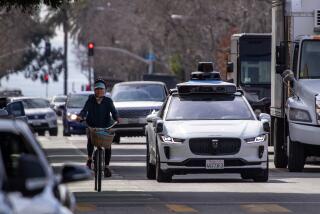Toyota sudden-acceleration lawsuits focus on lack of brake override
In a tactical shift, lawyers suing Toyota Motor Corp. over sudden acceleration are building their cases around the automaker’s resistance to installing a brake system that they claim would have prevented deaths and injuries.
The emerging legal strategy is centered on Toyota’s slow adoption of so-called brake override systems, which attorneys say is the automaker’s single biggest vulnerability as it defends itself against more than 100 lawsuits in state and federal courts.
Toyota discussed adopting brake overrides with federal safety regulators as early as 2007, documents show. But the automaker did not begin installing them until last year, after issuing massive recalls linked to the sudden-acceleration problem.
“We’re in a good position, from a litigation point of view, that there was a reasonable safety alternative and Toyota elected not to include it,” said Donald Slavik, a Milwaukee attorney who is handling four suits against the automaker and is on the steering committee for personal-injury cases in federal court and California state court.
Slavik and other plaintiffs’ attorneys previously focused on potential flaws in electronic throttle control systems. Slavik said that although lawyers still think the vehicles have electronic defects that can cause sudden acceleration, “our whole case doesn’t rest on it.”
Toyota spokesman Mike Michels said the new strategy “raises the question of why they are abandoning their basic case and reaching for a new one.” He suggested it could be because plaintiffs may have difficulty proving electronic defects exist.
“We look forward to the time when they are compelled to specify exactly what is defective, backed up by scientifically reliable proof rather than speculation,” Michels said.
Attorneys are seeking unspecified damages against the Japanese automaker, alleging that Toyota and Lexus vehicles prone to unwanted acceleration caused hundreds of injuries and deaths in accidents over the last decade. Toyota has settled at least one case so far, paying $10 million to the families of four people killed when a Lexus ES accelerated out of control near San Diego in 2009.
Brake override is an electronic fail-safe that automatically releases the throttle when a car’s onboard computer senses that the brake is depressed. Designed for cars with electronic throttle control, which use wires and software rather than mechanical cables to connect the gas pedal to the engine, it has been available for nearly a decade.
Other carmakers including Nissan, Volkswagen, BMW and Chrysler have been using brake override for years. Plaintiffs’ lawyers said that fact, combined with statistics from government safety databases showing lower levels of sudden-acceleration complaints for vehicles with brake override, will be central to their cases.
Lawyers also plan to cite company documents indicating that Toyota resisted overtures from the National Highway Traffic Safety Administration to install the technology.
E-mails and company memoranda obtained by Congress show that NHTSA investigators approached Toyota about installing a brake override in August 2007. The following year, the automaker ordered an internal feasibility study of the technology.
“Toyota has a legal problem just with the lack of the brake override system,” said Raymond Paul Johnson, a Los Angeles attorney representing a man who claims that a defect in his 2005 Camry caused it to accelerate off a cliff in Pismo Beach, killing his wife.
That position got a boost last month from U.S. District Judge James Selna, who is handling most of the federal cases against Toyota. In denying efforts by Toyota to dismiss most of the allegations against it, Selna noted “the absence of a brake override system.”
Lawyers are also likely to point to the $48.8 million in fines that Toyota has agreed to pay since April to the Transportation Department for failing to promptly notify regulators of defects or delaying recalls. They said that suggests a clear pattern of ignoring or downplaying important safety issues.
Edgar Heiskell, who represents the family of a Michigan woman killed when her Camry struck a tree, said he has taken depositions of Toyota employees who admit to knowing about brake override technology for years. “It is the most obvious defect,” he said.
Toyota contends that even with brake override, many of the accidents could not have been avoided, and that the override systems are being installed in all models now as an “extra measure of confidence.”
“Brake override only works when your foot is on the brake,” spokesman Michels said.
The automaker acknowledges that some of its vehicles had floor mats that could entrap accelerator pedals, as well as gas pedals that could stick and leave the throttle open. But it has said many of the incidents described in lawsuits suggest that some other problem was at fault, such as drivers stepping on the wrong pedal without realizing it.
A comprehensive report by NASA on the causes of sudden acceleration is expected early this year.
In addition to personal-injury and wrongful-death suits, Toyota faces claims from car owners alleging that the value of their vehicles has been diminished by defects. In the last 15 months, the automaker has issued more than 11 million recall notices worldwide, the bulk of which were related to sudden acceleration.
Attorney John Gomez, who negotiated the $10-million settlement from Toyota for relatives of the 2009 Lexus ES crash victims, said that if the case had gone to trial, he would have focused largely on the vehicle’s lack of brake override.
“On that angle alone, it’s a strong case,” said Gomez, who has a case pending against the dealership that lent the vehicle to the victims.
Still, many lawyers and safety experts involved in the Toyota cases say they’re not willing to give up on tracking down an electronic defect. In the legal discovery process, attorneys are seeking access to the source code used by Toyota to program the onboard computer that contains vehicles’ black box data recorders, as well as access to the diagnostic tool used to read such devices.
They hope that access to the code could help them challenge contentions from Toyota that human error was involved and reveal any software errors or hardware defects that could cause sudden acceleration.
“That’s the dream scenario,” Slavik said. “The good news is we don’t need that to have a case.”







